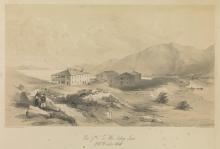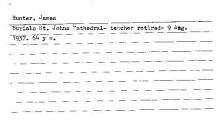Sai Wan Barracks [c.1845-????]
Primary tabs
Submitted by Herostratus on Fri, 2020-01-24 11:03
Current condition:
Demolished / No longer exists
Date Place completed:
c.1845-01-01 (Year, Month, Day are approximate)
Built in the early 1840s when the British first took possession of Kong Kong



Comments
The barracks are shown on
The barracks are shown on Collinson's 1845 map. A copy of the map can be seen at http://www.hkmaps.hk/mapviewer.html, which shows a dotted line marking the boundary of the military land.
That boundary was marked on the ground with boundary marker stones at its corners. The marker stone for the northern corner still survives: https://gwulo.com/node/35716
Completed in 1844 ...
... as stated in ON THE MILITARY STATIONS, BARRACKS, AND HOSPITALS, OF HONG KONG, written in 1846 and printed as Article 1 on page 3 of Transactions Of The Medical and Physical Society of Bombay, 1847 & 1848. I'll reproduce the section about Saiwan Barracks (beginning on p.26) below, but the whole document has lots more information about the early barracks in Hong Kong.
Saiwan is seven miles from Victoria, a little to the south of Lymoon pass, which separates Hong Hong [sic.] on the north-east from the main land. It is 200 feet above the level of the sea, on the side of a hill, which rises to the west from a small narrow peninsula in Saiwan Bay. This bay has Mount Parker on its west, 1,753, and Pottinger Peak on its south, 1,070 feet high, but is immediately bounded in both these directions by lower hills which are cut into terraces, rising behind each other, near their base, for the cultivation of rice. The rice fields are fed by streams, from between the hills which fall into the bay, and the mixture of which with its water, remains stagnant during the ebb tide, and doubtless contributes to the remarkable prevalence of Ague at this station.
The Barracks are built on a platform, 290 by 270 feet in length and breadth, while the cantonment occupies a surface of 1,900, by 1,500 feet at one end, and 1,100 at the other. The buildings are permanent and were completed in 1844. They consist of a house for one Captain and four Subalterns; a Barrack, originally intended for 100 Europeans ; but by the more liberal accommodation now given by the Ordnance Department, appropriated to 84 only; a hospital, planned for 25, and now furnishing 18 patients and 2 orderlies, with 900 cubic feet each, the maximum allowance; and a guard house, with a dry room, 3 cells and an Orderly room, as well as Guard room in it. The Officers’ Quarters are 12 feet above the level of the men’s, while the Hospital and Guard house have an elevation intermediate betwixt them.
The Men's barrack has a north-easterly and south-westerly aspect, and consists of one large apartment in the middle, and 3 small at each end of each floor, with spacious verandahs betwixt the last, in front and rear, and openings, which form door-ways on the ground floor, betwixt them at the ends. The walls of plastered brick are 2 feet thick, floors boarded, roofs tiled, windows glazed and jalousied, the lower ventilators guarded externally by iron bars, and provided within with sliding shutters. The large rooms are 84 feet long, 22 broad, 12 high, on the ground, 13 on the upper floor. Four of the smaller rooms are used as the Canteen Serjeants’ Quarter, and Clothing Store. The rest, as well as both large rooms, are appropriated to the accommodation of Non-Commssioned [sic.] Officers and men.
Each floor of the Hospital consists of a ward, 35 feet long, 21 feet 10 inches broad, and 12 feet high, with a stair case at one end, several small apartments in the corners of the other, for hospital Serjeant, Surgery and Stores, and verandahs betwixt them. The dimensions of the two wards together are 1,558 square, 18,340 cubic feet, which, at 900 per man, the maximum hospital rate, gives accommodation for 18, and at the minimum rate of 700 per man, 24 patients, and 2 orderlies.
The post is supplied with water from a stream betwixt it and Mount Parker. In addition to surface drains of granite, which surround every building, there is a large semi-circular trench, about 100 feet from the west end of the Officers' quarters, and on a higher level, 7 feet deep, and 5 or 6 wide, which materially contributes to the dryness of the surface, by diverting the water from the summit and higher parts of the hill, into vallies on either side terminating in Saiwan bay.